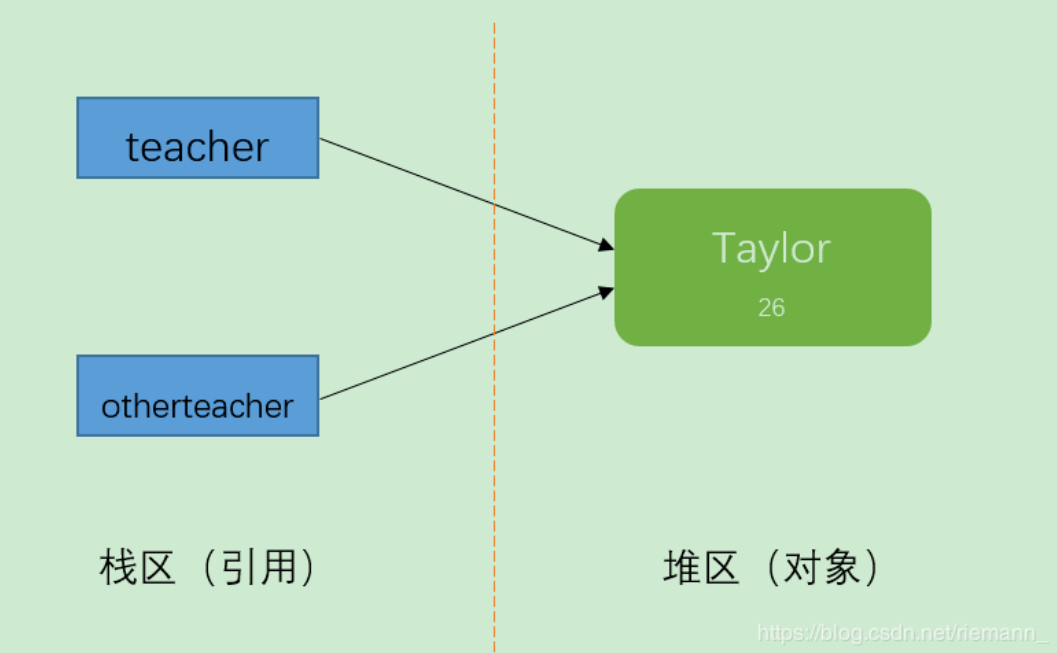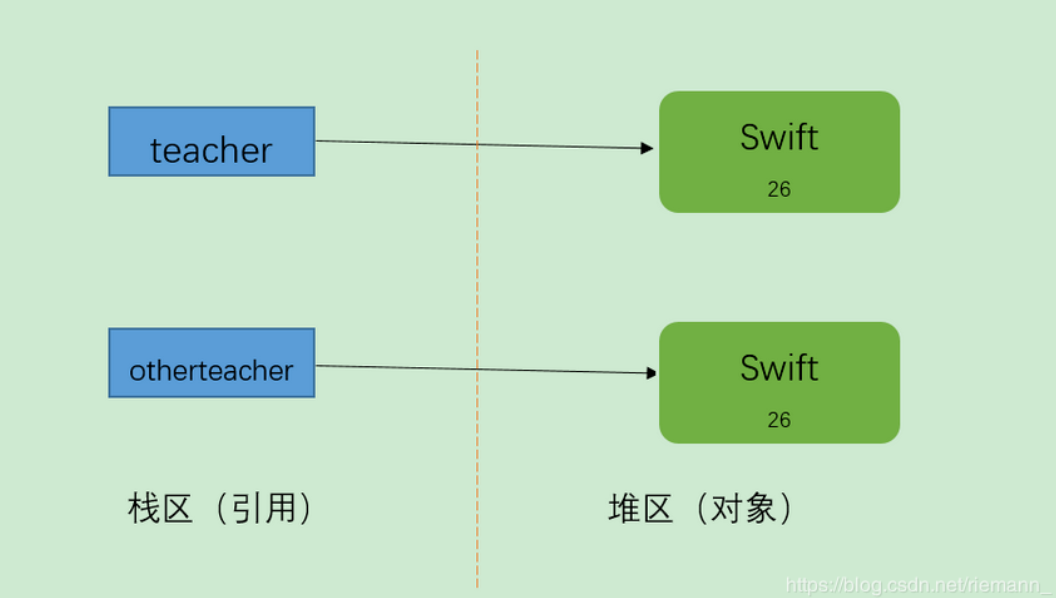一、拷贝的引入
(1)、引用拷贝
创建一个指向对象的引用变量的拷贝。
Teacher teacher = new Teacher("Taylor",26);
Teacher otherteacher = teacher;
System.out.println(teacher);
System.out.println(otherteacher);
输出结果:
blog.Teacher@355da254 blog.Teacher@355da254
结果分析:由输出结果可以看出,它们的地址值是相同的,那么它们肯定是同一个对象。teacher和otherteacher的只是引用而已,他们都指向了一个相同的对象Teacher(“Taylor”,26)。这就叫做引用拷贝。

(2)、对象拷贝
创建对象本身的一个副本。
Teacher teacher = new Teacher("Swift",26);
Teacher otherteacher = (Teacher)teacher.clone();
System.out.println(teacher);
System.out.println(otherteacher);
输出结果:
blog.Teacher@355da254 blog.Teacher@4dc63996

注:深拷贝和浅拷贝都是对象拷贝
二、浅拷贝
(1)、定义
被复制对象的所有变量都含有与原来的对象相同的值,而所有的对其他对象的引用仍然指向原来的对象。即对象的浅拷贝会对“主”对象进行拷贝,但不会复制主对象里面的对象。”里面的对象“会在原来的对象和它的副本之间共享。
简而言之,浅拷贝仅仅复制所考虑的对象,而不复制它所引用的对象
(2)、浅拷贝实例
package com.test;
public class ShallowCopy {
public static void main(String[] args) throws CloneNotSupportedException {
Teacher teacher = new Teacher();
teacher.setName("riemann");
teacher.setAge(27);
Student2 student1 = new Student2();
student1.setName("edgar");
student1.setAge(18);
student1.setTeacher(teacher);
Student2 student2 = (Student2) student1.clone();
System.out.println("拷贝后");
System.out.println(student2.getName());
System.out.println(student2.getAge());
System.out.println(student2.getTeacher().getName());
System.out.println(student2.getTeacher().getAge());
System.out.println("修改老师的信息后-------------");
// 修改老师的信息
teacher.setName("Games");
System.out.println(student1.getTeacher().getName());
System.out.println(student2.getTeacher().getName());
}
}
class Teacher implements Cloneable {
private String name;
private int age;
public String getName() {
return name;
}
public void setName(String name) {
this.name = name;
}
public int getAge() {
return age;
}
public void setAge(int age) {
this.age = age;
}
}
class Student2 implements Cloneable {
private String name;
private int age;
private Teacher teacher;
public String getName() {
return name;
}
public void setName(String name) {
this.name = name;
}
public int getAge() {
return age;
}
public void setAge(int age) {
this.age = age;
}
public Teacher getTeacher() {
return teacher;
}
public void setTeacher(Teacher teacher) {
this.teacher = teacher;
}
public Object clone() throws CloneNotSupportedException {
Object object = super.clone();
return object;
}
}
输出结果:
拷贝后 edgar 18 riemann 27 修改老师的信息后------------- Games Games
结果分析:两个引用student1和student2指向不同的两个对象,但是两个引用student1和student2中的两个teacher引用指向的是同一个对象,所以说明是浅拷贝。
三、深拷贝
(1)、定义
深拷贝是一个整个独立的对象拷贝,深拷贝会拷贝所有的属性,并拷贝属性指向的动态分配的内存。当对象和它所引用的对象一起拷贝时即发生深拷贝。深拷贝相比于浅拷贝速度较慢并且花销较大。
简而言之,深拷贝把要复制的对象所引用的对象都复制了一遍。
(2)、深拷贝实例
package com.test;
public class DeepCopy {
public static void main(String[] args) throws CloneNotSupportedException {
Teacher2 teacher = new Teacher2();
teacher.setName("riemann");
teacher.setAge(27);
Student3 student1 = new Student3();
student1.setName("edgar");
student1.setAge(18);
student1.setTeacher(teacher);
Student3 student2 = (Student3) student1.clone();
System.out.println("拷贝后");
System.out.println(student2.getName());
System.out.println(student2.getAge());
System.out.println(student2.getTeacher().getName());
System.out.println(student2.getTeacher().getAge());
System.out.println("修改老师的信息后-------------");
// 修改老师的信息
teacher.setName("Games");
System.out.println(student1.getTeacher().getName());
System.out.println(student2.getTeacher().getName());
}
}
class Teacher2 implements Cloneable {
private String name;
private int age;
public String getName() {
return name;
}
public void setName(String name) {
this.name = name;
}
public int getAge() {
return age;
}
public void setAge(int age) {
this.age = age;
}
public Object clone() throws CloneNotSupportedException {
return super.clone();
}
}
class Student3 implements Cloneable {
private String name;
private int age;
private Teacher2 teacher;
public String getName() {
return name;
}
public void setName(String name) {
this.name = name;
}
public int getAge() {
return age;
}
public void setAge(int age) {
this.age = age;
}
public Teacher2 getTeacher() {
return teacher;
}
public void setTeacher(Teacher2 teacher) {
this.teacher = teacher;
}
public Object clone() throws CloneNotSupportedException {
// 浅复制时:
// Object object = super.clone();
// return object;
// 改为深复制:
Student3 student = (Student3) super.clone();
// 本来是浅复制,现在将Teacher对象复制一份并重新set进来
student.setTeacher((Teacher2) student.getTeacher().clone());
return student;
}
}
输出结果:
拷贝后 edgar 18 riemann 27 修改老师的信息后------------- Games riemann
结果分析:
两个引用student1和student2指向不同的两个对象,两个引用student1和student2中的两个teacher引用指向的是两个对象,但对teacher对象的修改只能影响student1对象,所以说是深拷贝。
关于Java深拷贝和浅拷贝区别,你学废了么?
- 区别:如果在拷贝这个对象的时候,只对基本数据类型进行了拷贝,而对引用类型数据只是进行了引用的传递,而没有真实的创建一个新的对象,则认为是浅拷贝。反之,在对引用类型数据进行拷贝的时候,创建了一个新的对象,并且复制其内的成员变量,则认为是深拷贝。
问:clone()方法,是对当前对象进行浅拷贝,引用类型依然是在传递引用,那么,如何进行一个深拷贝呢?
- 序列化这个对象,再反序列化回来,就可得到这个新的对象,无非就是序列化的规则需要自己来写。
- 继续利用clone()方法,既然clone()方法是我们来重写的,实际上可以对其内的引用类型的变量,在进行一次clone()。